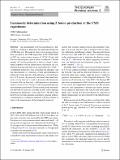Luminosity determination using Z boson production at the CMS experiment
Author(s)
Unknown author
Download10052_2023_Article_12268.pdf (2.686Mb)
Publisher with Creative Commons License
Publisher with Creative Commons License
Creative Commons Attribution
Terms of use
Metadata
Show full item recordAbstract
The measurement of Z boson production is presented as a method to determine the integrated luminosity of CMS data sets. The analysis uses proton–proton collision data, recorded by the CMS experiment at the CERN LHC in 2017 at a center-of-mass energy of 13
$$\,\text {Te\hspace{-.08em}V}$$
Te
V
. Events with Z bosons decaying into a pair of muons are selected. The total number of Z bosons produced in a fiducial volume is determined, together with the identification efficiencies and correlations from the same data set, in small intervals of 20
$$\,\text {pb}^{-1}$$
pb
-
1
of integrated luminosity, thus facilitating the efficiency and rate measurement as a function of time and instantaneous luminosity. Using the ratio of the efficiency-corrected numbers of Z bosons, the precisely measured integrated luminosity of one data set is used to determine the luminosity of another. For the first time, a full quantitative uncertainty analysis of the use of Z bosons for the integrated luminosity measurement is performed. The uncertainty in the extrapolation between two data sets, recorded in 2017 at low and high instantaneous luminosity, is less than 0.5%. We show that the Z boson rate measurement constitutes a precise method, complementary to traditional methods, with the potential to improve the measurement of the integrated luminosity.
Date issued
2024-01-10Department
Massachusetts Institute of Technology. Department of PhysicsPublisher
Springer Berlin Heidelberg
Citation
The European Physical Journal C. 2024 Jan 10;84(1):26
Version: Final published version